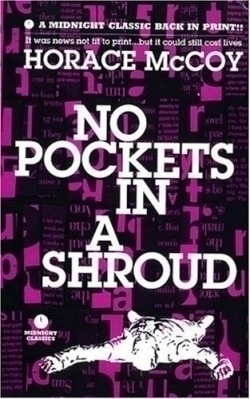It looks like you've stumbled upon a page meant to be read by our code instead of viewed directly. You're probably looking for this page.
No Pockets in a Shroud
No Pockets in a Shroud and three other titles (They Shoot Horses, Don’t They?, Kiss Tomorrow Goodbye and I Should Have Stayed Home) in the Serpent’s Tail Midnight Classics series mark the resurrection of Depression-era American writer Horace McCoy (1897-1995).
In Shroud, tougher-than-nails newspaper reporter Mike Dolan is sick of the corruption permeating all levels of life in his every-city of Colton, including his job at a newspaper that has been bribed into withholding facts from the public. He quits the paper and starts a magazine of his own, intending solely to hang out everyone’s dirty laundry-baseball players who are paid to drop the ball, the sloppy abortionist, crooked cops, racist terror groups with ties to city hall. Soon friends and enemies alike are turning up dead or maimed, but Dolan soldiers on in his mission to print the truth.
Shroud probably wasn’t found on too many library shelves when it was first published in 1937, and it will continue to raise eyebrows today, particularly among the politically correct. In McCoy’s world, women are oversexed and not immune to getting slugged in the jaw; minority groups are referred to in less than glowing terms; and fascists tend to be homosexuals. On the other hand, thick-skinned readers will be treated to a true show of linguistic force.
The story is told almost entirely through crisp and lively dialogue that frequently swells into raging torrents of remarkably brutal language. No words are minced on setting and imagery, and McCoy is both economic and effective in his choice of words. Stark reflections on “…the wetness of the smell and the utter loneliness of the city” are both the backdrop to the story and Dolan’s only refuge from the desperation and corruption around him.
Fans of Charles Bukowski and Ernest Hemingway will appreciate Horace McCoy’s violent style and his dark vision of an America caught in the throes of economic, social and moral disintegration. McCoy’s work is both an excellent example of the action-thriller genre of the 1920s and ’30s and a style that is uniquely American.
Disclosure: This article is not an endorsement, but a review. The publisher of this book provided free copies of the book to have their book reviewed by a professional reviewer. No fee was paid by the publisher for this review. Foreword Reviews only recommends books that we love. Foreword Magazine, Inc. is disclosing this in accordance with the Federal Trade Commission’s 16 CFR, Part 255.
